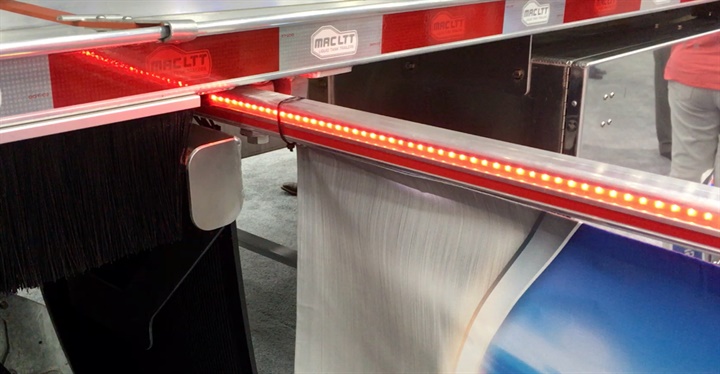Trump appears furious with his deputy attorney general after a wild 2 days — and ‘resignation is a real serious possibility’
President Trump appears increasingly angry with Deputy Attorney General Rod Rosenstein —...
President Trump appears increasingly angry with Deputy Attorney General Rod Rosenstein —...
Stevadores unload containers from the Northern Magnum, a Panamax container ship, at Charleston. Photos: Tom Berg
">Stevadores unload containers from the Northern Magnum, a Panamax container ship, at Charleston. Photos: Tom Berg
">If you want to see a busy place, visit the Port of Charleston, S.C. Container operations there are busier after the facility upgraded its automated gate identification to a faster system. Also, the port is seeing more container shipments to the U.S. East Coast since the enlarging of the Panama Canal.
Of course, containers move over highways on special chassis pulled by normal road tractors, which use that gate. Port authorities call each movement in or out a "truck mission." Within the port, the steel “boxes” are hauled by purpose-built tractors and trailers.
A group of us truck writers saw a lot of them on a recent visit to the port that was sponsored by Mack Trucks and arranged by one of its customers, Pat Barber, founder, president and CEO of Superior Transportation. He set up the tour with port officials, and Mack hired a bus to carry us through the sprawling facility.
The port also has break-bulk and RO-RO (roll-on, roll-off) operations. Barber's Macks and Kenworths haul machinery and other large, heavy cargoes to and from the break-bulk section using lowboy trailers, some of them with multiple axles.
Huge gantry cranes were unloading the Northern Magnum as our bus rolled up and we got off to watch. About once every minute or two, a steel “box” dropped onto a trailer and a rig moved briskly away, heading toward a “stack” where it would be temporarily stored. Such operations proceed until a ship is relieved of its many loaded containers and then reloaded with a mix of loaded and empty boxes for export. Like other busy ports, Charleston operates 24 hours a day.
Each Panamax-size ship like the one we saw carries 5,000 to 12,000 containers measured by 20-foot-equivalent ...Read the rest of this story
Image: Federal Motor Carrier Safety Administration
">Image: Federal Motor Carrier Safety Administration
">The Federal Motor Carrier Safety Administration has begun to take specific action to comply with President Trump's Executive Order 13771 that agencies relieve businesses of burdensome regulations.
To that end, the agency gave a presentation on June 12 to the appointed members of its Motor Carrier Safety Advisory Committee, which has been tasked with making recommendations on which federal highway safety rules might be eliminated.
“To introduce a new FMCSA assignment to the Motor Carrier Safety Advisory Committee members, agency staff prepared a short PowerPoint presentation outlining some possible 'regulatory relief' candidates that could be suggested or included in response to the Presidential Executive Order," FMCSA Spokesman Duane DeBruyne told HDT.
"MCSAC, which is comprised of a broad representation of all of FMCSA's stakeholders, is now tasked to come up with their own independently derived recommendations." he added.
The presentation laid out 12 commercial-vehicle rules that FMCSA staff had determined were candidates for being dropped. MCSAC's task is not easy, given that all the rules in place were implemented with a safety purpose in mind.
Some of the dozen rules were selected by the agency for regulatory review by the committee because they are simply outdated or because they are no longer enforced for one reason or another.
For example, per the presentation, the Motor Carrier Routing Regulations (under Part 325) could be dropped as they are a remnant of the shuttered Interstate Commerce Commission and therefor it is questionable whether they still "serve a purpose." It was suiggested their elimination would "simplify regulations and have no significant economic impact."
Other rules proposed for the chopping block by agency staff include measures touching on other reporting requirements and some requirements covering medical records, employment application, and road test results for non-CDL drivers, as well as some cooperating ...Read the rest of this story


You might think it's crazy that Microsoft is once again introducing a new game console with a...

MAC Liquid Tank Trailers has developed an auxiliary lighting system for gasoline trailers intended to improve safety during nighttime filling station deliveries. The Total Area Lighting Kit (TALK) provides bright white LED light strips above the discharge tube area and on the steps of the ladder to help drivers better see what they are doing in darkness.
The TALK system also includes two 8-foot-long light bars that swing out from stowed mounting positions along the body of the trailer. These have red LED on the front and back to provide a very obvious work-zone barrier to help keep cars from wandering into the area while the driver is unloading. White LED strips along the bottom of the bars light up the work area. There are strobe lights on the tips of the bars to provide additional awareness of the driver's work area.
MAC LTT President Jim Marion said the idea came from customers who were looking for solutions keep their drivers safe while they are unloading. "We had heard stories of drivers getting mugged and backed into while they were unloading at night," he explained. "We wanted to provide a way to make that work environment safer and better lit so drivers can better see what they are doing."
Because the TALK system uses only LED, the current draw will be minimal and won't compromise healthy batteries during the unloading process.
The TALK system is available on new trailers from MAC and Marion says it will also be available retrofit through the aftermarket.
Follow @HDTrucking on Twitter
...Read the rest of this story